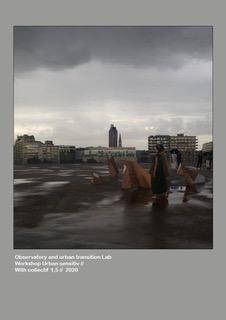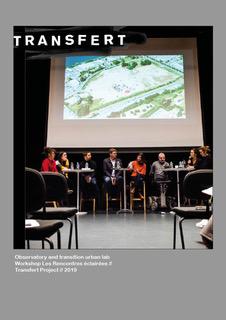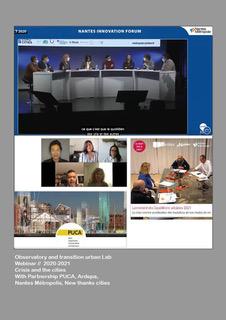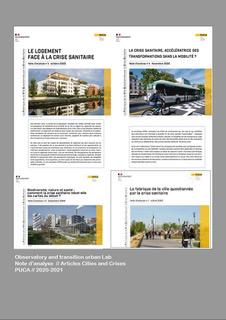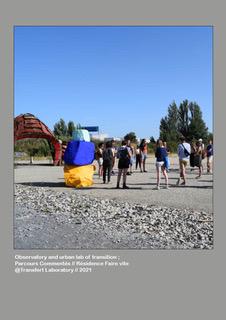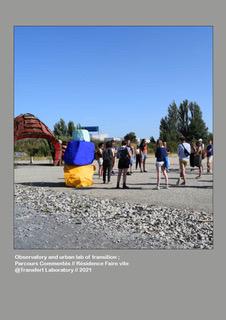I. SUMMARY INFORMATION
Project
269265
Status
Submitted
Award category
Reinvented places to meet and share
You want to submit
NEW EUROPEAN BAUHAUS AWARDS : existing completed examples
Project title
Observatory of Urban Transitions
Full project title
Participatory observatory of urban transitions in the Loire region
Description
The observatory is a project conceived with two minds and four hands during the health crisis. It is the result of a journey through the meanders of the urban fabric between research and action. It aims to federate initiatives and knowledge on cities in the face of transitions (ecological, citizen). A virtual place, it becomes a real place during residencies in the Loire region. A place for observation and debate, it implements a city factory outside the usual circuits.
Where was your project implemented in the EU?
France
Pays de la Loire
4 allée Susan Brownell Anthony
Nantes
44200
When was your project implemented?
Has your project benefited from EU programmes or funds?
No
Which programme(s) or fund(s)? Provide the name of the programme(s)/fund(s), the strand/action line as relevant and the year.
II. DESCRIPTION OF THE PROJECT
Please provide a summary of your project
A 360° transition is awaiting the cities of the 21st century. To meet all the challenges ahead, alliances must be created with new actors. Among them, artists, citizens, ecologists, landscape architects and doctors have their place. The Observatory is making its contribution to meeting these challenges. It is conceived as a workshop open to probable and improbable encounters, a place for decompartmentalisation, a useful and undisciplined place.
To this end, the project is divided into 4 complementary parts:
Observe: an online public watch on 8 themes related to the urban fabric and its transitions in the face of the health crisis. It is completed by analysis notes distributed by the PUCA (Urbanism Construction Architecture Plan) to its partners (researchers, local authorities, urban professionals). This component began in June 2020.
Decompartmentalisation: collaborations are already underway with :
> researchers via research projects on the urban fabric and its innovations or experiments (Demextra project, ANR Scaena)
> artists' collectives (Transfert project, collectif 1.5.)
> citizens: drafting of a manifesto "For a dialogued city factory, Usages and Transitions, doing things together and for tomorrow" for the actors of the urban factory of Nantes metropolis.
> Practitioners: regular collaborations with actors of the city factory at local (SAMOA, Nantes Métropole), national (PUCA) and international (UN Habitat/ Urban Maestro) levels.
Doing: organisation of workshops and action-research, research-creation, design thinking and citizen workshops in specific locations.
Sharing: knowledge and results with schools, universities, associations and professionals. This aspect will eventually be completed by exhibitions in various places, the results of residencies with researchers/ artists/ practitioners/ citizens.
Please give information about the key objectives of your project in terms of sustainability and how these have been met
The sustainability of the project is envisaged under different aspects which can be broken down into 3 objectives:
1/ Recycle the places: use the places that already exist for residences and exhibitions.
This way of intervening makes it possible to highlight existing wastelands, to show the potential for rehabilitation of spaces that are sometimes considered to be of low quality. It is also a pretext for involving the inhabitants of the site or neighbourhood in the issues of urban transformation and transition.
2/ Federate and circulate: existing initiatives and link them. Ultimately, our objective is not to build "yet another" project, but to federate, interweave and highlight the initiatives that exist in the area. It is a project imagined as a sort of "urban shaker" to allow innovation and collaboration between researchers, professionals and students, and citizens of a territory.
The project generates the circularity of knowledge and resources present in the Loire region (Pays-de-La-Loire region).
3/ Making transitions a central object of the urban fabric:
The observatory questions transitions in the city. Indeed, the health crisis makes it possible to bring together the reflections in a convergence of health, ecological and social crises. It is no longer a question of thinking about the city and then providing solutions for transitions, but rather of thinking about the city through the prism of its transitions.
Please give information about the key objectives of your project in terms of aesthetics and quality of experience beyond functionality and how these have been met
Through our research-action, research-creation methods, the project aims to
produce urban ambiences. The aim is to move away from a purely functional approach to urban design, by taking into account its aesthetic and sensitive aspects. This is an opportunity for us to :
1 / to question urban ambiences through the prism of transitions;
> To raise awareness of the challenges of rehabilitation and renovation of existing built heritage
> To exploit the dramaturgical potential of places through a sensitive and sensory exploration
> Qualify the intangible heritage of cities through investigation methods between research and creation
2/ Break out of the usual practices and bring together the worlds of experts and citizens to co-construct new urban aesthetics
> produce sensitive maps of places
> build shared urban imaginations
> to create a common and shared narrative of transitions
3/ The ultimate objective is to enable a "relational quality of place", where interaction, encounters and knowledge sharing are more favourable. It is a question of imagining places where we feel good.
Methods: For this purpose, urban walks with artists, researchers and local residents are carried out to map the spaces in a sensitive manner. All this leads to the implementation of urban scenography devices that make the common narrative of the transition palpable.
Please give information about the key objectives of your project in terms of inclusion and how these have been met
The project aims to include different audiences: students/urban professionals/artists/researchers/citizens, both upstream (observation, cross-research, prototyping workshops etc.) and downstream (training, exhibitions, mediation).
Workshops are planned for young people, architecture professionals (Ardepa) and the elderly. The observatory aims at an intergenerational public and a mixed public between experts and laymen.
The observatory has objectives to develop audiences, particularly extra-regional and international, through its digital component, its reinforced presence on social networks (linkedin, twitter, instagram, facebook) and the monthly organisation of events.
This digital component will be strengthened through the creation of a website at the end of 2021.
Please give information on the results/impacts achieved by your project in relation to the category you apply for
>> From a digital observation site (adapted to the particular health context) we wish to hybridise the project and bring together the digital and real worlds. The creation of the online platform has enabled a cross-fertilisation of knowledge, and is a starting point for the "real" meeting of people.
>> Hacking the places, to reinvest them; Occasional investigations of places are initiated to allow improvisation and meeting in a bottom-up approach. We propose to seize the atmosphere of the place to make a project, and to imagine intervention devices such as urban scenographies to change the way of looking at things.
>> We use the notion of "infinite places" to describe what we want to put in place: open, possible and unfinished places that allow for open programming that is conducive to improvisation and new uses. In other words, places that reflect the social role of architecture.
Please explain the way citizens benefiting from or affected by the project and civil society have been involved in the project and what has been the impact of this involvement on the project
In 2019, Nantes won the European Innovation Capital Award thanks to its way of co-designing public policies and the city with citizens. We have contributed to this adventure by writing the manifesto "Fabrique de la ville dialoguée, Usages et Transitions, faire ensemble et pour demain". The observatory takes up the principles set out in this manifesto: expertise in use, working with, proposing a dialogue with citizens at all stages of the project from diagnosis to design/programming, including the use management phase.
The projects for ephemeral places set up within the framework of the Observatory will thus be co-designed and run with citizens and with particular attention to the mix of audiences (intergenerational, researchers, artists, practitioners).
Please highlight the innovative character of the project
The Observatory is innovative in several ways:
In its method :
>> no operation in silos, but a transversal project
>> bringing together the worlds of research and action, actors in the field, users and researchers
>> design thinking approaches; a human-centred investigation method that integrates the citizen at all stages of the process.
>> taking the gamble of shared expertise can offer promising avenues of innovation that go off the beaten track. Dealing with transitions in a "useful and undisciplined" workshop could encourage innovation in an incremental approach.
>> shared and open source research approaches
In its form:
>> The observation is thought in a hybridization between digital and physical space.
>> The project is deployed in several places, according to the residencies and partnerships
>> The punctual investigation of the places, the work around the "urban ambiences" favourable to the meeting which still function after our passage will reveal the infinite character of the places and will allow other actors to seize them.
Please explain how the project led to results or learnings which could be transferred to other interested parties
The Urban Transitions Observatory provides a body of knowledge and practices that could be shared and implemented in other cities and territories (on a national and international scale).
Partnerships have already been set up in this respect with the Universities of Tokyo and Tohoku (JAPAN), or with European projects (Urban Maestro/UN Habitat).
The Urban Transitions Observatory builds bridges between the research community, urban professionals, experts and citizens in an incremental approach. The latter will be documented in the long term in order to encourage sharing and inter-knowledge with other projects in other cities. The documentation does not only concern the exploitation of the research results but also wishes to inform, in the image of open source logic, the processes and innovative practices induced by the project. This "documentation" of the project takes various forms, from a small guidebook, to a walk-show with partner collectives such as 1.5, to a workshop with students in the form of urban crossings. These different media make it possible to raise awareness among a varied public and to go beyond the circle of initiates.
Is an evaluation report or any relevant independent evaluation source available?
No
III. UPLOAD PICTURES
IV. VALIDATION
By ticking this box, you declare that all the information provided in this form is factually correct, that the proposed project has not been proposed for the Awards more than once under the same category and that it has not been subject to any type of investigation, which could lead to a financial correction because of irregularities or fraud.
Yes
